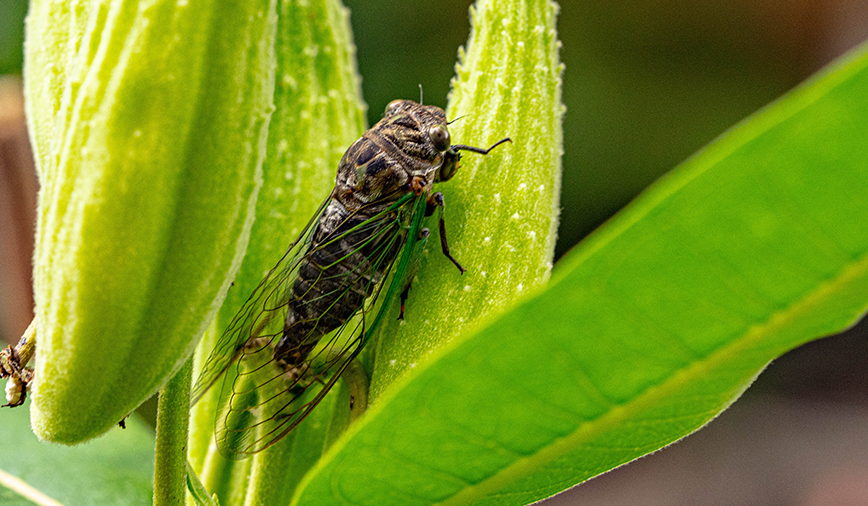Pam’s Perspective
From the…
Pam Otto is the Manager of Natural Programs and Interpretive Services for the St. Charles Park District
August 23, 2013
When was the last time you saw a little green man?
For me, it was last Saturday. I was walking through the Hickory Knolls savanna when something small and bright caught my eye. I looked more closely and there he was, all shiny and chartreuse: a freshly emerged cicada, clinging to his now-empty shell.
Cicadas are reliable performers in nature’s summer symphony, sounding off from July through September from the branches of trees throughout the Tri-Cities. But their loud finish stands in stark contrast to their quiet beginnings.
The adult insects we’re hearing right now started off as eggs that were laid between two and five years ago, depending on species. Way back then a little woman, or female cicada, used her saw-like ovipositor to cut slits at the end of a branch and laid eggs under the bark. Upon hatching, the tiny nymphs – smaller than a grain of rice – dropped to the ground and dug in. There they remained, feeding on plant roots and shedding their hard outer skin, or exoskeleton, four or five times before finally clawing their way back up above ground for one final molt.
If you happen to find a cast exoskeleton, or exuvia, take a look at the forelegs and you’ll see how well adapted cicada nymphs are for tunneling through the earth. Thick and powerful looking, the juvenile legs have a bulk even Popeye would be proud of.
They look much different from the legs of an adult cicada, which typically spends the few weeks of its short life above ground high in a tree. The insect’s objective has
switched from feeding to breeding, and that’s where the sound comes in.
Male cicadas are choristers, sending out species-specific songs in an effort to find a mate and complete their circle of life. Using special sound-producing structures called tymbals, located where the abdomen meets the thorax, they advertise their fitness and availability to female cicadas that likely are listening nearby.
Chances are you’ve been listening in as well, whether you want to or not. Cicadas are among our loudest insects. I remember sitting in a classroom along the quad at the University of Illinois at Urbana-Champaign one warm August day. The windows were open, and I could hear the cicadas more clearly than I could the professor.
As I recall, they were more interesting, too.
If you listen closely, you’ll notice that different species make different sounds; they also call during different times of day. Some, like the dog day cicada, Tibicen canicularis, produce an even tone that rises in both pitch and volume before sputtering off at the end, and is commonly heard in the afternoon and evening until dusk. Others, like the scissor-grinder cicada, Tibicen pruinosa, make a slow, pulsating sound, also in afternoon in the evening. And the lyric cicada, Tibicen lyricen, sings a song with a vibrating quality, mainly in the morning and early afternoon.
Soon, though, the cicada-song season will soon be drawing to a close. Already it’s not hard to find dead ones on the streets and sidewalks. Some have been predated (cicadas not only are noisy, but also nutritious), while others are just plain done.
While many cicadas are winding down, a few are just starting up. This weekend, keep your eyes open as you walk past tree trunks, fence posts, even garages. You may spot your own little green man!
Pam Otto is the manager of nature programs and interpretive services at the Hickory Knolls Discovery Center, a facility of the St. Charles Park District. She can be reached at potto@stcparks.org or 630-513-4346.

